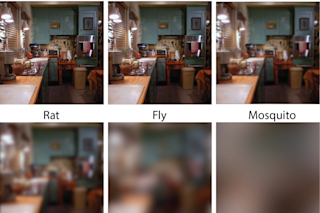Animals have us beat in basically every test of sensory perception. Bats bounce ultrasonic waves to locate prey, and bears can smell a carcass from miles away.
But our abilities are respectable in one category: visual acuity. A study published recently in the journal Trends in Ecology & Evolution shows that humans see the world in finer detail than almost any other living creature.
Scientists measure visual acuity in “cycles per degree,” the number of black-and-white parallel lines an animal can see in one degree of its vision. This is what determines how sharp objects appear, and it depends on how far the viewer is from what they’re viewing.
Compiling visual acuity estimates for about 600 species, the researchers found that the range of detail visible across the animal kingdom stretches across four orders of magnitude, with humans just below the top.
We see roughly 60 cycles per degree, and ...















